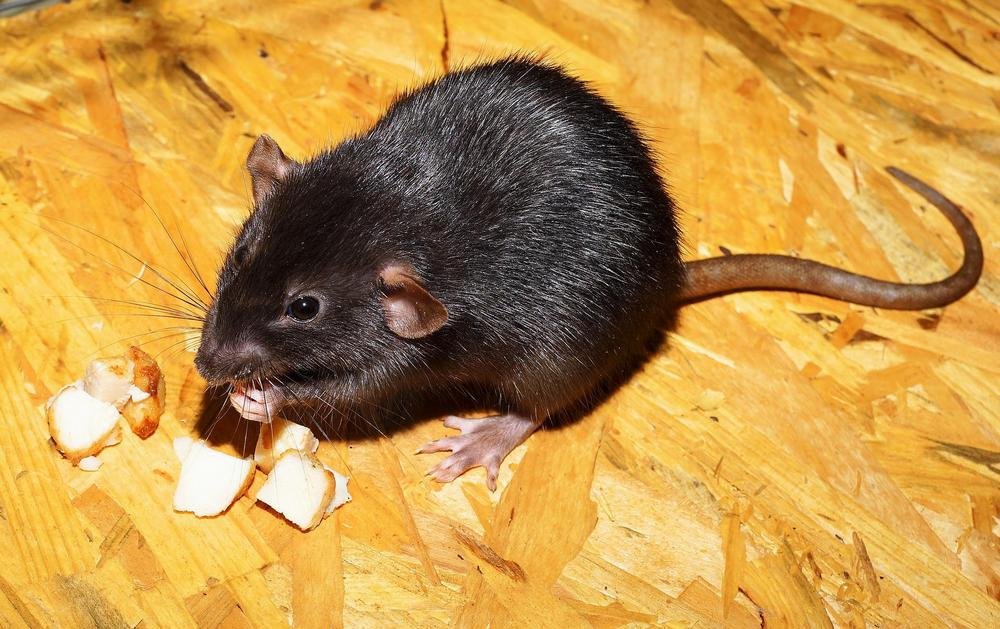
Dogs do it too. In fact, the yorkie was originally bred to hunt rats.
They no longer have that job these days.
But they do still have that instinct.
It is very possible your pup might catch and kill a rat on one of your nature walks.
If that happens, are there any diseases your yorkie can catch from the rat?
There most definitely are. Keep reading to learn which diseases yorkies can catch from rats and what you need to do to prevent it from happening.
Contents
Diseases Yorkies Can Catch From Rats
The following four diseases are ones that yorkies can catch from rats. But, as you’ll see, they can be transmitted in other ways, too.
Tularemia Or Rabbit Fever
Francisella tularensis causes tularemia, a bacterial disease. It’s also known as rabbit fever because it affects wild animals, particularly rabbits and rodents.

Tularemia is uncommon in dogs, but they can catch it if they kill or consume an infected rabbit or rodent. A bite from an infected blood-sucking bug, such as a tick or flea, may also cause infection.
Even pet rodents can carry this disease. According to the CDC, domestic cats and hamsters bought from pet stores have been known to spread the disease.
If your dog encounters a dead animal, particularly a wild rabbit or rodent, be cautious and don’t allow your pup to eat it. Dogs may also contract the disease if they drink tainted water. The best flea and tick collar for Yorkies can help prevent this.
Tularemia symptoms include a loss of appetite, lethargy, and a moderate fever. Inflammation of the skin, draining abscesses, and swollen lymph nodes are also possible symptoms.
Rat Bite Fever
Rat-bite fever is another disease you might need to worry about. It transmits to your dog through contact with dead rodents. Your pup can also catch it by ingesting something that was tainted by the feces of a diseased rat.
But the most common cause is a bite or scratch from an infected rat. The bacteria that causes rat-bite fever is common in the mouths of rats and up to 10% of rat all bites can lead to infection.

Mice, gerbils, squirrels, cats, and dogs that come into contact with rats may become infected and spread the disease. They can spread it regardless of whether or not they become ill.
Even household pets like hamsters, rats, mice, and rabbits that come into contact with wild animals can carry the bacteria. They can pass it on to humans or other household pets like dogs.
Potentially Fatal Toxoplasmosis
The parasite toxoplasma gondii causes toxoplasmosis. It’s a parasite that affects humans and warm-blooded animals like rats all over the world.
The parasite only has one host: wild and domestic cats. And they are needed to complete the parasite’s life cycle. Dogs may contract the infection, but you will never notice if the adult dog is otherwise safe.
Puppies are more susceptible to the disease. Symptoms of toxoplasmosis may occur in an animal with a compromised immune system. These are the symptoms.
Consumption of cysts from cat urine, contaminated rodents, or infected meat are the common pathways for dogs to become infected. Interestingly, rats infected with the toxoplasmosis parasite become less fearful of cats and even like cats’ scents. They can become easy prey for yorkies or other dogs, because they lose their natural fear of predators.
Leptospirosis In Dogs

Leptospirosis is a deadly and easily transmissible disease. It is caused by a genus of bacteria called leptospira that lives in the kidneys of infected animals. When the virus is found in humans, it’s also known as Weil’s disease. Rats and cattle are two of the most common carriers.
How To Prevent Infection With Rat Diseases
Sanitation is the best way to keep your yorkie from coming into contact with an infected rodent. Keeping your dog from interacting with wild animals is also important.
Clean your hands after playing with a cat, before interacting with your dog. Do it more often, if you have house rats or other rodents as pets. Take your dog to the doctor, if you think he has an illness or if it has had contact with a wild animal.
Bred To Catch Rats
The Yorkshire Terrier is a small dog breed that belongs to the toy category. The playful personality and distinctive blue and tan coats of the long-haired terrier are well-known. They are big reasons this breed surpassed the Labrador Retriever as the second most popular dog breed in the United States in 2006.
Yorkies can be very thin, weighing no more than seven pounds on average. The American Kennel Club does not prescribe a minimum weight or height requirement for dogs.
Yorkshire Terriers were originally bred to capture rats in Yorkshire mills and mines during the Industrial Revolution. Their small size was a huge advantage.
During this time (the nineteenth century), migrants from Scotland flocked to Yorkshire. They came in search of jobs in the many mills and mines that dot the landscape.
They brought many small terriers of various breeds with them as companions. It was the mixing of these breeds that led the creation of the yorkie. There are no records as to which breeds specifically are part of the yorkie’s makeup.
However, it is widely assumed that they brought the following breeds with them and all are part of the Yorkshire Terrier’s lineage.
- Clydesdale
- Paisley
- Skye Terriers
Yorkies were excellent ratters in northern England’s mills and mines. Their small size and courage was ideal for hunting rats, along with a variety of other rodents. The dogs were small enough to fit in hunters’ pockets before being released into the dens of wild animals.

Yorkshire Terriers, despite their small size, seemed to enjoy the excitement of the chase. They didn’t even back down when faced with prey larger than themselves, demonstrating that they are a brave breed.
Popularity
This dog breed transitioned from a hunting/ratting dog to a companion dog during the Victorian era. Small dogs were considered precious during this time.
The breed’s peculiar appearance and small stature drew the attention of royalty and upper-class societies in England. As the breed’s popularity grew in England, it spread to the United States.
Yorkies Introduction To The US
In 1861, the Yorkshire Terrier was first seen in England as the Broken Haired Scotch Terrier. However, the Yorkshire Terrier became the official name of the breed in 1874. This dog breed started to make its way into America in 1872. The American Kennel Club (AKC) formally recognized the breed in 1878.
Famous Yorkshire Terriers

The following are two famous Yorkshire terriers who have made their way into the history books.
Huddersfield Ben
Huddersfield Ben is a well-known Yorkshire Terrier. He is the breed’s base sire. He was given the name Huddersfield after the town where he was born in Yorkshire, England. He had a significant influence on the evolution of the breed ever since.
A man named M.A. Foster was the owner of this dog. Foster became well-known after winning over 70 dog shows and several ratter competitions with his dog.
That fame made Ben the most coveted stud dog on the market. He was relatively big at 11 pounds, but he regularly produced litters of dogs weighing less than 5 pounds (2.26 kg), which conformed to the breed standard at the time. Ben died at the age of six in 1871, when he was run over by a carriage.
Smokey
The Yorkshire Terrier’s popularity started to dwindle in the 1940s. But Smoky changed that. She was a famous World War II dog. As a member of the 5th Air Force in the Pacific, she was regarded as a hero. Her outstanding service helped to reintroduce this breed to the mainstream public.
Smoky was originally discovered in a shell hole near the Japanese lines in New Guinea by American William Wynne. She was unable to comprehend commands issued in either English or Japanese.
She joined the troop and participated in over 150 airstrikes and 12 sea missions. Her bravery was lauded after she survived a treacherous typhoon in Okinawa.
She quickly learned clever tricks while serving with her American troops. These tricks not only amused the troops but also helped her to assist the Signal Corps.
She did so by bringing a telegraph wire through a 70-foot, eight-inch pipe. Smokey also used a custom-made parachute to leap from a 30-foot tower.
Modern Day Yorkie Requirements

Because of their small size and modest activity requirements, yorkies make great apartment dogs and are also perfect senior pets. But they are not just good in apartments. They need a lot of exercise, so having a house with a yard is great, too.
But if you have a yard for your Yorkie, double-check it for escape routes, because these dogs are small and can crawl under fences easily.
They like frolicking, but they are not yarded dogs that should be left alone for extended periods. You could also read our article on how to train a dog to stay in the yard.
If your Yorkie gets bored, or it its stomach feels upset, you may witness it munching on some grass like a cow, leaving you wondering: why does my Yorkie eat grass. In addition to the two reasons above, it may also just be bored, or simply like the taste of the grass.
Due to their small size, you should feed yorkies two to three smaller meals daily, instead of one larger one. They are also prone to hypoglycemia. It’s always a good idea to consult your veterinarian about the best food to feed your yorkie.
Yorkies do not like being left alone for long periods and are susceptible to separation anxiety. They really just want to accompany you everywhere you go, because they are classic purse dogs. Yorkies are known for following their owners around the home.
As mentioned above, yorkies need to exercise to burn off all that excess energy. You should take your pup on two walks a day of at least 15 minutes each.
You should also give your dog two or three high intensity exercise sessions per week. This can be anything that has your dog running a lot, like a game of catch or just chasing each other around.
Yorkies can keep up with you no problem on medium-length walks and intense play sessions due to their stamina. But when they are tired, they will refuse to go any further. You’ll probably have to carry your dog home.
Yorkie Rat Diseases: Conclusion
Despite being bred to capture rodents, yorkies are just as susceptible as any other breed to a variety of diseases that rats carry. But rats aren’t the only way the can catch many of these diseases.
Although not all of these diseases are deadly, they pose significant health hazards to both your dog and yourself. It is best to prevent any contact between your yorkie and rats, along with any type of wild animal. Take precautions to keep your pet, and you, safe.
Leave a Reply